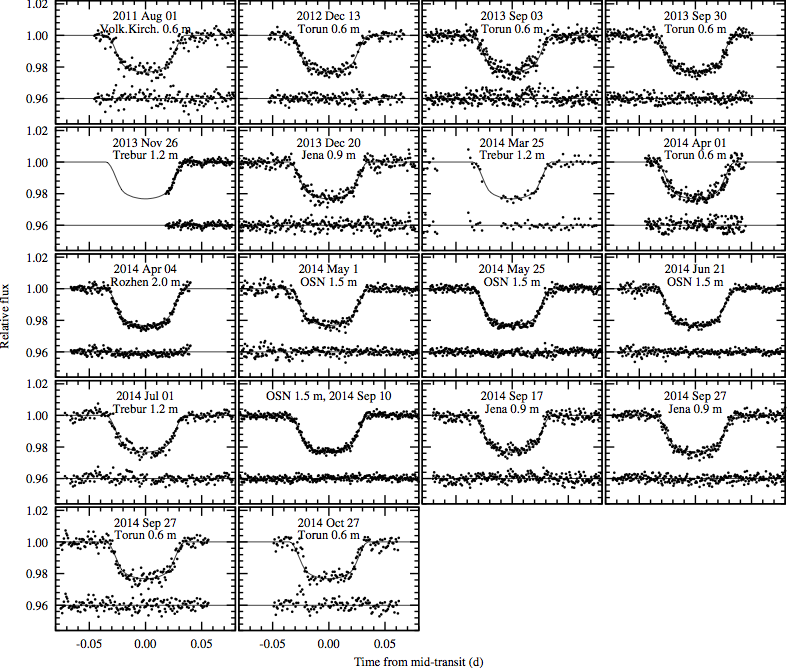Qatar-1 b
AIMS
Qatar-1 b is a typical hot Jupiter with a mass of 1.09 M_Jup and a radius of 1.16 R_Jup (Alsubai et al. 2011). The planet orbits its host star within 1.4 d on a circular orbit. The radial velocity observations throughout a transit show a signature of the Rositter-McLaughlin effect, consistent with a sky-projected obliquity close to zero (Covino et al. 2013).
More recently, von Essen et al. (2013) have found indications for a possible long-term TTV signal. The periodicity of this signal is postulated to be close to 190 or 390 days with the peak-to-peak amplitude of about 2 min. New timing observations will allow us to confirm or refute the postulated TTVs, and to put tighter constraints on the mass of the possible perturber as a function of its orbital distance.
RESULTS
We have collected 18 useful transit light curves:

The analysis of transit times shows that there is no periodic TTV signal and transit times are consistent with a linear ephemeris:

STATUS
The campaign is ended. The results are being prepared for publication.
LIGHT CURVES
Reliable
| No. | Date | Instrument | Comment |
| 1 | 2011 Aug 01 | Volkssternwarte Kirchheimlast 0.6 m | |
| 2 | 2012 Dec 13 | Torun 0.6 m | |
| 3 | 2013 Sep 03 | Torun 0.6 m | |
| 4 | 2013 Sep 30 | Torun 0.6 m | |
| 5 | 2013 Nov 26 | Trebur 1.2 m | |
| 6 | 2013 Dec 20 | Jena 0.9 m | |
| 7 | 2013 Dec 20 | Trebur 1.2 m | |
| 8 | 2014 Mar 25 | Trebur 1.2 m | |
| 9 | 2014 Apr 01 | Torun 0.6 m | |
| 10 | 2014 May 16 | OSN 1.5 m | |
| 11 | 2014 May 25 | OSN 1.5 m | |
| 12 | 2014 Jun 21 | OSN 1.5 m | |
| 13 | 2014 Jul 01 | Trebur 1.2 m | |
| 14 | 2014 Aug 21 | Torun 0.6 m | |
| 15 | 2014 Sep 03 | Torun 0.6 m | |
| 16 | 2014 Sep 10 | OSN 1.5 m | |
| 17 | 2014 Sep 17 | Jena 0.9 m | |
| 18 | 2014 Sep 17 | Torun 0.6 m | |
| 19 | 2014 Sep 27 | Jena 0.9 m | |
| 20 | 2014 Sep 27 | Torun 0.6 m | |
| 21 | 2014 Oct 27 | Torun 0.6 m |
PI: Gracjan Maciejewski gmac@umk.pl